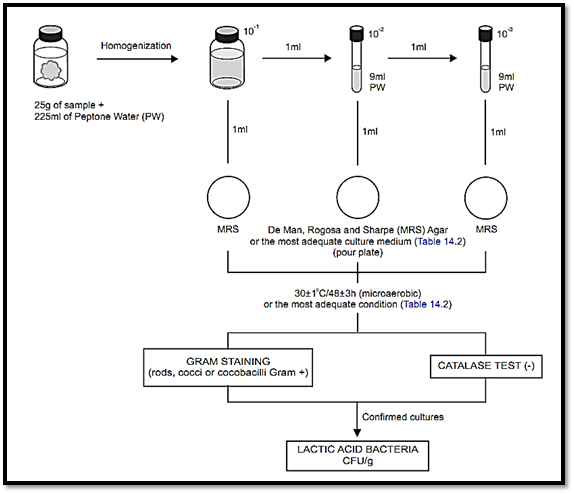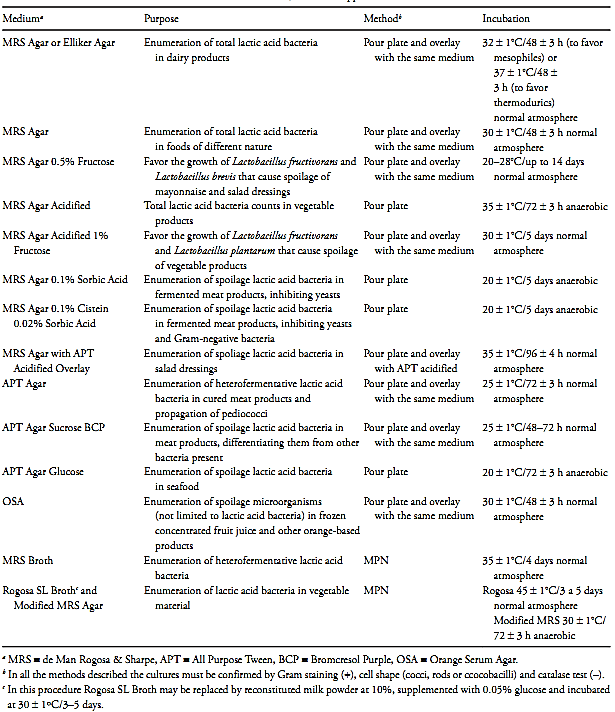


 النبات
النبات
 الحيوان
الحيوان
 الأحياء المجهرية
الأحياء المجهرية
 علم الأمراض
علم الأمراض
 التقانة الإحيائية
التقانة الإحيائية
 التقنية الحيوية المكروبية
التقنية الحيوية المكروبية
 التقنية الحياتية النانوية
التقنية الحياتية النانوية
 علم الأجنة
علم الأجنة
 الأحياء الجزيئي
الأحياء الجزيئي
 علم وظائف الأعضاء
علم وظائف الأعضاء
 الغدد
الغدد
 المضادات الحيوية
المضادات الحيوية|
Read More
Date: 8-3-2016
Date: 18-3-2016
Date: 6-3-2016
|
Plate count method APHA 2001 for lactic acid bacteria in foods
Method of the American Public Health Association (APHA), as described in the 4th Edition of the Compendium of Methods for the Microbiological Examination of Foods (Hall et al., 2001) and 17th Edition of the Standard Methods for the Examination of Dairy Products (Frank & Yousef, 2004).
1 - Material required for analysis
Preparation of the sample and serial dilutions
• Diluent: 0.1% Peptone Water (PW)
• Dilution tubes containing 9 ml 0.1% Peptone Water
(PW)
Plate count
• Culture media: De Man, Rogosa and Sharpe (MRS)
Agar or the most adequate culture medium indicated in Table 1
• Microaerobic or anaerobic gas-generating kits (if recommended in Table 1)
• Laboratory incubator set to 30 ± 1°C or the most adequate temperature indicated in Table 1
Confirmation
• Gram Stain Reagents
• 3% Hydrogen Peroxide
2 - Procedure
A general flowchart for the enumeration of lactic acid bacteria in foods using the plate count method APHA 2001 is shown in Figure 1.
Attention. The Compendium recommends that the samples intended for the enumeration of lactic acid bacteria be not frozen, because of the high sensitivity of these microorganisms to injuries caused by freezing. If the product is normally frozen, it should not be thawed and re-frozen prior to being subjected to the analyses.
a) Preparation of the sample and serial dilutions.
However, Butterfield’s Phosphate Buffer should not be used to prepare the samples, since it may cause injuries to the cells. The recommended diluent is 0.1% Peptone Water (PW).
Note a.1) To homogenize samples for counting lactic starter cultures in fermented products, it may be advantageous to use a blender, to break up chains of lactic acid bacteria. This is particularly useful for freshly manufactured products, and may result in more accurate counts of the bacteria present.
b) Inoculation. Select three adequate dilutions and inoculate 1 ml of each dilution in empty, sterile Petri dishes. Next, add De Man, Rogosa and Sharpe (MRS) Agar to the plates or the most adequate culture medium indicated in Table 1.
In those situations in which the use of overlay is recommended in Table 1, wait until the agar is completely solidified and add a small amount of the medium recommended to be used for the overlay, covering the surface of the inoculated medium.
c) Incubation. Incubate the MRS plates inverted at 30 ± 1°C/48 ± 3 h in microaerobic conditions or follow the incubation conditions established in Table 1. Plates with an overlay may be incubated under a normal atmosphere and plates without overlay must be placed inside a jar with an anaerobic or microaerophilic atmosphere, in accordance with the recommendation given in Table 1. To obtain an anaerobic atmosphere (anaerobiosis), commercially available anaerobic atmosphere-generating systems, such as the BD Biosciences GasPak® Anaerobic Systems, Anaerogen (Oxoid), and Anaerocult A (Merck) systems may be used. Microaerophilic atmospheres can also be generated using commercially available systems, such as the Anaerocult C (Merck).
d) Confirmation of the colonies and calculating the results. Select for counting the plates with 25 to 250 colonies and count all. Select at least five colonies present on the plates and subject to Gram staining and catalase test. The Gram-positive (cocci or rods) and catalase-negative colonies are considered con-firmed as lactic acid bacteria. Calculate the number of CFU/g or ml as a function of the number of con-firmed colonies and the inoculated dilution.
Example: Pour plate, 10−2 dilution, 25 colonies present, five subjected to confirmation, four con-firmed (80%). CFU/g or ml = 25 × 102 × 0.8 = 2.0 × 103.

Figure 1 Scheme of analysis for the enumeration of lactic acid bacteria in foods using the plate count method APHA 2001 (Hall et al., 2001).
Table 1 Culture media for lactic acid bacteria counts in foods, their main applications and forms of use.

References
Silva, N.D .; Taniwaki, M.H. ; Junqueira, V.C.A.; Silveira, N.F.A. , Nasdcimento , M.D.D. and Gomes ,R.A.R .(2013) . Microbiological examination methods of food and water a laboratory Manual. Institute of Food Technology – ITAL, Campinas, SP, Brazil .
Frank, J.F. & Yousef, A.E. (2004) Tests for groups of microorganisms. In: Wehr, H.M. & Frank, J.F (eds). Standard Methods for the Examination of Dairy Products. 17th edition. Washington, American Public Health Association. Chapter 8, pp. 227–248, Section 8.071.
Hall, P.A., Ledenbach, L. & Flowers, R.S. (2001) Acid-producing microorganisms. In: Downes, F.P. & Ito, K. (eds). Compendium of Methods for the Microbiological Examination of Foods. 4th edition. Washington, American Public Health Association. Chapter 19, pp. 201–207.



|
|
|
|
إجراء أول اختبار لدواء "ثوري" يتصدى لعدة أنواع من السرطان
|
|
|
|
|
|
|
دراسة تكشف "سببا غريبا" يعيق نمو الطيور
|
|
|
|
|
|
قسم الشؤون الفكرية يقيم برنامج (صنّاع المحتوى الهادف) لوفدٍ من محافظة ذي قار
|
|
|
|
الهيأة العليا لإحياء التراث تنظّم ورشة عن تحقيق المخطوطات الناقصة
|
|
|
|
قسم شؤون المعارف يقيم ندوة علمية حول دور الجنوب في حركة الجهاد ضد الإنكليز
|
|
|
|
وفد جامعة الكفيل يزور دار المسنين في النجف الأشرف
|